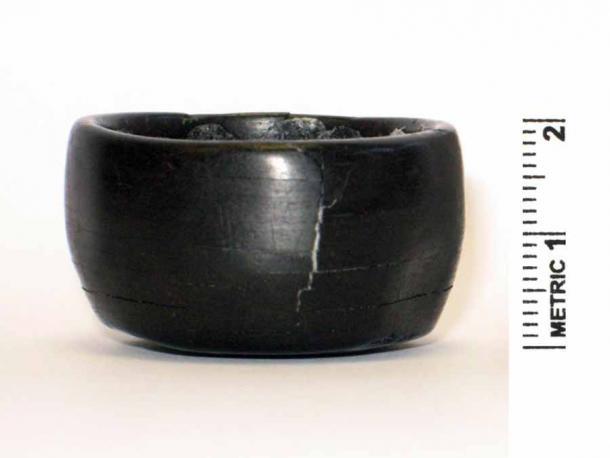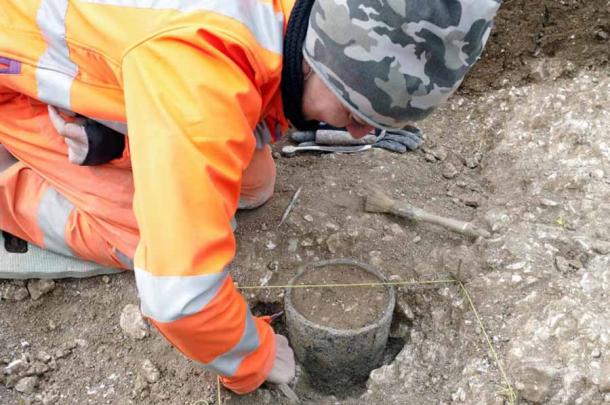Archaeologists digging at England’s controversial Stonehenge A303 tunnel site have unearthed Neolithic pottery, Bronze Age burials and a mysterious C-shaped enclosure.
The area has been suffering from increasingly heavy traffic causing serious congestion on the 8 mile (13 kilometer) long A303 between Amesbury and Berwick Down that runs past the 4,500-year-old Stonehenge UNESCO World Heritage Site in Wiltshire, England. The proposed solution is the Stonehenge tunnel project: a highly-controversial 2-mile-long (3.3 kilometer) twin-bore tunnel being built beneath the iconic ancient monument.

Besides finding Stonehenge graves, archaeologists from Wessex Archaeology also unearthed Neolithic pottery. ( Wessex Archaeology )
Archaeologists Concerned About Impact of Stonehenge Tunnel
In a January 2020 Ancient Origins news article I explained that a wave of English archaeologists voiced their concerns about Highways England, English Heritage and the National Trust’s plans for the new £1.7bn tunnel. Professor Mike Parker Pearson is a member of Highways England ’s independent A303 scientific committee and he told The Guardian that the planned tunnel “might cause irreparable damage.” In another Guardian report archaeologists were reported as fearing the works might lead to “the loss of hundreds of thousands of artifacts.”
Not only are archaeologists concerned about the safety of the ancient standing stone circle itself, but also about the surrounding Wiltshire landscape. Dr. Pearson said the entire region was “crucial to the mechanics of the astronomical observatory as the stones are themselves.” Now, archaeologists conducting preliminary excavations at the new road site have “hand dug and sieved” almost 1,800 test pits and have recorded more than 400 new trial trenches making a slate of new discoveries which included Stonehenge graves.

Archaeologists discovered a unique shale object near a Stonehenge grave during excavations being conducted before the construction of a controversial tunnel. ( Wessex Archaeology )
The Tip of the Archaeological Iceberg…
The archaeologists at Stonehenge from Wessex Archaeology recently announced the discovery of Neolithic grooved ware pottery, Bronze age graves, the remains of a “mysterious C-shaped enclosure” and a range of ditches. An article in The Guardian says the Neolithic pottery was discovered just to the south of the site of the Stonehenge visitor center close to the planned western end of the tunnel entrance. The remains of a baby’s ear bones were found in a small, plain pottery beaker, and in a 4,000-year-old Beaker-period burial pit grave nearby a man’s remains and “a unique shale object” were discovered. The researchers are yet unclear what this shale artifact was but its thought to have been “the tip of a ceremonial wooden staff, or a mace (club).”
Matt Leivers is a consultant archaeologist at Wessex Archaeology. Speculating on the origin of the Neolithic pottery he said it was probably buried by the people who built the famous stone circle. Alternatively, it might be the case that it was ritually deposited by a group of people who visited the sacred site. Located beside the Stonehenge burials , the “C-shaped enclosure” was flanked by deep ditches that were found to contain burnt flint fragments and red deer antlers. The researchers believe that this was probably “a prehistoric industrial area […] where metal, leatherworking, pottery manufacture or crop processing was carried out.”
Digs at the eastern portal of the planned Stonehenge tunnel revealed significant quantities of “debitage,” the waste material produced in the manufacture of flint tools. A series of Iron Age ditches were also unearthed at the eastern aspect of the dig site which are thought to be associated with the nearby Vespasian’s Camp , an Iron Age hill fort close to the town of Amesbury to the south.
It’s Full Steam Ahead into Phase II
David Bullock, a Highways England project manager for the A303 tunnel, told The Guardian that the next phase of archaeological excavations will begin later this year and that the excavations will last approximately 18 months, “involving up to 150 archaeologists.” Bullock reassures the concerned masses that “a huge amount of investigations” have been undertaken to assure the new tunnel “can be threaded through so as to disturb as little as possible.” Highways England agree with Bullock and said the amount of survey work that had been carried out was “unprecedented,” because of the immense significance of the Stonehenge site.
After the 18 months have passed, the Stonehenge landscape will have been reformed and transformed. Then, the planned construction project will begin on the actual tunnel in 2023. The Stonehenge Alliance believes that “no further damage should be done to the archaeological landscape of Stonehenge,” and that anything shorter than a 2.8-mile-long (4.5 km) deep bored tunnel “would cause irreparable damage to this landscape, in breach of the World Heritage Convention.” At the time of writing, 202,390 people had signed the Stonehenge alliance petition for a longer tunnel. However, their proposed tunnel measures over twice as long as the one that has been budgeted for at £1.7bn per 2-mile-stretch (3.3 kilometer), so it’s doubtful this will happen.
Top image: In excavations being conducted before the construction of a controversial tunnel next to Stonehenge, archaeologists have discovered Neolithic pottery, mysterious enclosures and Bronze Age burials. Source: Wessex Archaeology
By Ashley Cowie
Related posts:
Views: 0
 RSS Feed
RSS Feed















 February 6th, 2021
February 6th, 2021  Awake Goy
Awake Goy  Posted in
Posted in  Tags:
Tags: 
















